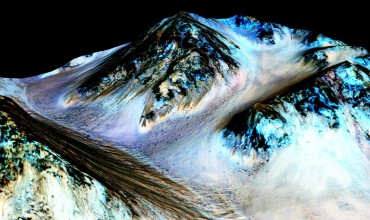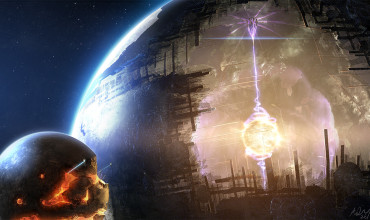We all know what we learned in school – our solar system has nine planets. For 75 years, until 2006, Pluto was on the planetary list, but then they discovered that Pluto doesn’t really belong there. They came up with a different category for planets like Pluto – dwarf planets.
Celestial bodies that are called planets orbit around the Sun, but aren’t another object’s satellite. They have hydrostatic equilibrium, which is a good balance between gravity and mass which makes them round. They’ve also cleared their neighborhood of other smaller bodies. Because Pluto didn’t make gravitational dominance in its orbit, or hasn’t cleared its neighborhood, but met two out of three conditions to be a planet, it is considered a dwarf planet.
Scientist say that there are potentially 200 objects in our Solar System that may be classified as dwarf planets, but so far they’ve classified just five – Ceres, Eris, Pluto, Makemake and Haumea.
Ceres is the closest planet to Earth. It is the largest object in the asteroid belt between Jupiter and Mars. It was discovered in 1801 by a Sicilian astronomer Giuseppe Piazzi. It’s very small, and has a mass of about 0.015 percent of Earth’s. Sometimes scientists refer to it as the queen of the asteroid belt because it contains about 1/3 of the whole belt. But because of its’ size,Ceres is known as one of the largest asteroids in the Solar System and the smallest dwarf planet of them all. Also, this is the first dwarf planet visited by a spacecraft in NASA’s Dawn mission. There are speculations about Ceres containing water and the interesting thing is that the highest temperature on Ceres is 38 degrees Celsius or 100.4 degrees Fahrenheit, which is pretty warm for space. Who knows, maybe someday this dwarf will develop into planet that can sustain life.
Pluto is the most famous dwarf planet. As I said, it was considered a 9thplanet in our Solar System until they discovered that Pluto has a busy Solar System on its own, with strong gravity that attracts 5 moons intercepting its orbit, and orbiting the Sun. Pluto’s location is in the Kuiper belt beyond Neptune, a region that is known for icy debris. Latest news about Pluto is amazing. With NASA’s mission New Horizons, we discovered how Pluto’s regions look, and what they are made of. But because it’s so far away, it takes Pluto 248 years to complete one circuit around the Sun, and it’s one of the coldest places in our Solar System with the temperature around -225 degrees Celsius or -375 degrees Fahrenheit. Ouch.
Two more dwarf planets orbit the Sun and are in the icy zone beyond Neptune Makemake and Haumea. Sometimes, Makemake, Haumea and Pluto are called “Plutoids” or “Ice dwarfs”, because they orbit that icy belt beyond Neptune, and of course because of their size.
Makemake is interesting because it lacks a satellite. Without a satellite it is hard to measure planet’s mass, but the assumptions are that it is about 2/3 of Pluto’s. Also, Makemake is the reason that Pluto isn’t considered a 9th planet in our Solar system anymore. It was discovered in 2005. It completes its circuit around the Sun every 310 years. And according to scientists, Makemake is the second brightest object found in the Kuiper belt, after Pluto, so it can be seen with an amateur telescope. It often seems that celestial bodies are called after some ancient Greek or Roman god/goddess, but Makemake got its’ name after the god of fertility in the Rapa Nui mythology of the Easter Islands.
Haumea is the most unique dwarf planet, because of its shape. Interestingly, Haumea is barely meeting hydrostatic equilibrium criteria to be on a dwarf planet list. The scientists say that its’ strange shape isn’t due to lack of mass – it has a mass of about 1/3 of Pluto’s, they say it’s because of its’ rapid rotational spins. It is one the fastest rotating objects in our Solar System. It is thought that Haumea is about the same size as Pluto, it’s made of rock and covered with ice.It spins around its’ axis every few hours, and it was discovered in 2003. To be called after a god/goddess of fertility is apparently popular, so this planet was called after one too. Haumea is the name of Hawaiian goddess of fertility and childbirth, and interestingly enough it’s moons are named after goddesses children. Haumea is the only one dwarf planet known to have more than one moon besides Pluto.
Finally, Eris, our cover image gal, was discovered in 2003. It is icy and it is a Pluto-size dwarf planet. Sometimes, scientists refer to it as the Pluto’s twin planet. Eris needs 557 years to orbit around the Sun because its’ orbit extends far from Kuiper belt, in the outer Solar System. It was named after the ancient Greek goddess of discord and strife, known for stirring up envy that caused fighting among men. The legend has it that this goddess even started the Trojan War. Because of its distance, the temperature ranges on this planet are big, from -359 degrees Fahrenheit or -217 degrees Celsius to -405 degrees Fahrenheit or -243 degrees Celsius, making Eris the coldest dwarf planet in our Solar System.

Like FoH?
Fists of Heaven is ad-free and always will be. If you enjoyed the content above, help us out by sharing this post, or by commenting and letting us know what content you like and want to see more of. Thanks for reading!





